Are you puzzled about selecting an ideal tech stack for a fuel delivery app?
When you are an entrepreneur, it's important to identify the ideal technology stack for your fuel delivery app. With a range of diversified technologies, it's easy to get confused and puzzled.
But not anymore.
Here we have provided you with the details about the technology stack, along with the factors impacting the same, and the process to select an ideal fuel-delivery app tech stack.
Let’s begin with the same, together.
Fuel-Delivery App and Why Create It?
The fuel delivery apps are designed to provide convenience to users who want to order fuel at any location. An online fuel delivery app is a platform that helps users order fuel via the app by stating the quantity, location, etc.
These apps can help users get any type of fuel assistance at any time, providing a popular refueling option.
Well, if you are still confused about why to use a fuel-delivery app tech stack, then the following points can be helpful.
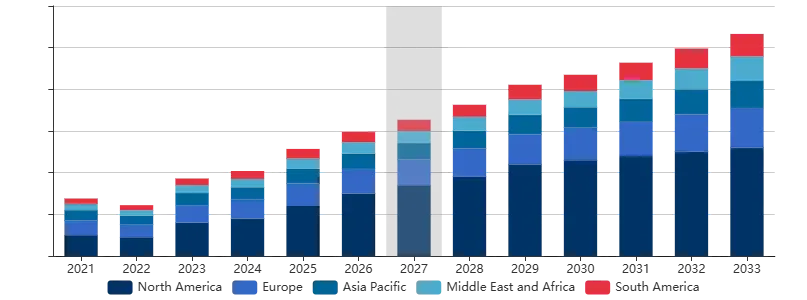
-
- The global on-demand fuel delivery app market size is estimated to be USD 251.2 million, where North America holds the major share of more than 40% of the global revenue, with the market size of USD 100.48 million in the year 2024, which will grow at a CAGR of 16.4%.
- However, the Mexico on-demand fuel delivery market is expected to grow at a CAGR of 16.9% during the forecasted period, reaching the market size of USD 9.14 million in the year 2024.
- When it comes to the United Kingdom, the on-demand fuel-delivery app market had a share of USD 12.66 million by the year of 2024, which is projected to grow at a CAGR of 17.5% within the forecasted period.
- Europe has accounted for a share of more than 40% of the global revenue, with a size of USD 75.36 million.
These stats represent a clear figure for why you should create a fuel-delivery app.
Well, one of the important segments in the development process is the technology stack. Here, an effective fuel-delivery app tech stack is important to consider.
In the given section, you should be able to learn about the fundamentals in brief.
Fundamentals of Tech Stack
Before you switch to the fuel-delivery app tech stack, it's essential to know the basics.
Here is the list to be considered.
1. Front End Tech Stack
Let’s begin with the user side.
The front-end tech stack is all about the set of technologies used to create the user-facing part of the website and apps.
In the front-end tech stack, you will find technologies such as HTML, CSS, JavaScript, and frameworks, depending on the aim of the project.
2. Backend Tech Stack
In the backend tech stack, the type of technologies you can include can be stated as programming languages, databases, and different frameworks. Let’s learn more about the backend tech stack in the points below.
-
- Programming Language: These are the popular choices made and used to write the server-side code, and they comprise languages such as Python, Java, PHP, and Go.
- Frameworks: These provide structure and tools to simplify development in a specific language. Examples include Django and Flask (Python), Express.js (Node.js), Spring (Java), and Laravel (PHP).
- Databases: These are used to store and manage application data. Options include relational databases like MySQL and PostgreSQL, and NoSQL databases like MongoDB.
- Servers: Web servers like Apache and Nginx handle client requests and deliver responses.
- Operating System: The underlying OS on which the server runs (e.g., Linux, Windows Server).
- Runtime Environment: The environment where the backend code executes (e.g., Node.js runtime, Java Virtual Machine).
The selection of these technologies differs based on different factors. Let’s have a quick check in the next section.
The Strategic Pillars of Tech Stack Choice
Want to know about the fuel-delivery app tech stack?
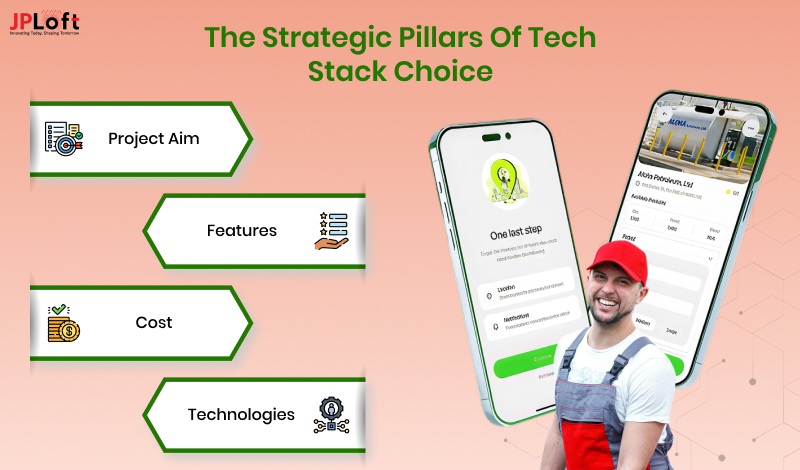
Well, it's vital to know the diversified factors impacting the tech stack. Let’s learn them all here.
► Project Aim
You need to answer two questions when it comes to the tech stack.
-
- Can your project's aim be achieved with the selected tech stack?
- What kind of components should be included to address the project’s aim?
One of the prime objectives of the tech stack is to achieve the aim of the defined project, hence, it should be clear at first.
► Features
Again, let’s understand the features' impact on the fuel-delivery app tech stack, based on two questions.
-
- Are you including the complicated features in the fuel-delivery app?
- What kind of tech stack will be required to support these selected features?
Fuel-delivery app features act as a blood, thus, it should be clarified once stepping ahead with the technology stack.
► Cost
The budget plays an important role while selecting a tech stack for your fuel-delivery app. Let’s figure out the given questions.
-
- How much will it cost to make a fuel-delivery app?
- What type of development cost, operational cost, and long-term risks are involved while selecting the technology stack?
Through cost, you can estimate the type of technology you can include to create the mobile app.
► Technologies
Yes, the type of technologies you want your app to have will have a large impact on the fuel-delivery app tech stack. You can answer the following questions for this factor's impact.
-
- Are you including the advanced technologies to create your dream fuel-delivery app?
- How can the use of advanced technologies enhance the overall tech stack selection process?
Considering the technologies, you can enhance the overall process to a suitable tech stack selection.
These were the fundamentals and factors you should consider.
We understand that while creating and selecting a suitable tech stack for your fuel-delivery app, it's vital to address the reasons to proceed with the same.
The following section can be helpful.
Why Select the Ideal Tech Stack for a Fuel Delivery App?
In his competitive environment, it's important to evaluate the reasons behind selecting an ideal fuel-delivery app tech stack.

Well, let’s learn that in this section.
1] Improves the Responsiveness
Fuel delivery apps heavily rely on real-time location tracking of drivers. Thus, by including an ideal tech stack in the fuel-delivery app, users will get easy access to the real-time updates.
From placing an order to dispatching a driver and processing payment, the entire flow needs to be fast and reliable. With a reliable backend, this can enhance the responsive timings.
2] Adds Flexibility to the App
Through a suitable tech stack, you can easily accommodate a growing number of users, drivers, and orders.
The chosen tech stack should be flexible enough to allow for the seamless integration of new functionalities like loyalty programs, different vehicle types, or integration with other services. Thus, an ideal technology is important to consider here.
3] Cost and Time Factor
The chosen tech stack should be flexible enough to allow for the seamless integration of new functionalities like loyalty programs, different vehicle types, or integration with other services.
The high cost you can pay, the latest technologies can be included in the app. Additionally, choosing a stack with mature tools and a well-established ecosystem can reduce development time and cost.
4] App Security
Fuel delivery apps handle sensitive user data like addresses, payment information, and location. Users expect the app security as they use their personal information in the app.
The chosen stack should facilitate building a robust and reliable system with minimal downtime. Ensuring the security and integrity of payment transactions is paramount. The backend needs to integrate securely with payment gateways.
5] Updates and Maintenance
Once your blog is live, time to move forward with app maintenance services.
A well-structured and documented codebase, often facilitated by mature frameworks, makes the app easier to maintain, debug, and update in the long run.
The chosen stack should facilitate the integration of high-maintenance tools and technologies smoothly.
These were the reasons that you should consider when it comes to selecting an ideal tech stack for the fuel-delivery app.
Now, it's time to learn them all successfully. The following section will detail it all.
Key Components of Fuel Delivery App Tech Stack
When you enter the industry of fuel-delivery apps, it's vital to go ahead with the technical aspect.
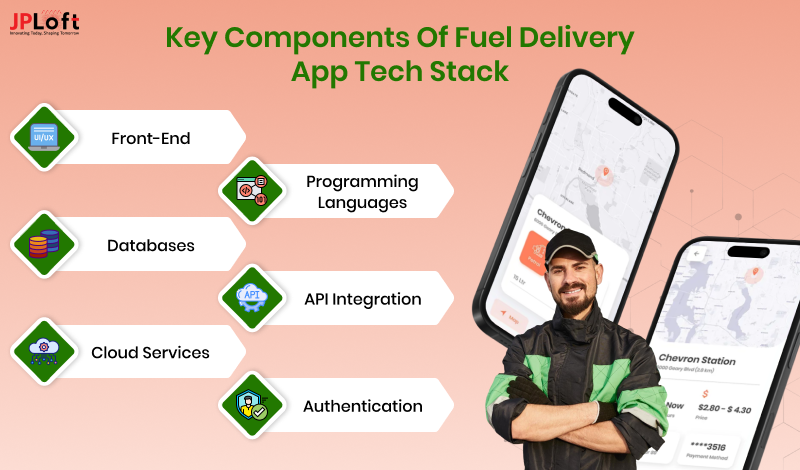
Let’s learn about the key components for a fuel delivery app tech stack here.
1. Front-end (UI/UX App Design)
Under this segment of the fuel-delivery app tech stack, you should frame the infrastructure for your app.
It should consist of a wireframe and a prototype that is required to be engaging. Here’s a fuel-delivery app design detail.
-
- React Native and Flutter: Here, the key segments comprise JavaScript, frameworks, and other development tools such as UI component libraries, mapping, and pages for streamlining the development procedure.
- HTML: This technology is used for managing the fuel-delivery orders, drivers, pricing, and analytics. It can influence the choice of the developers and their approach.
- CSS/JavaScript: Here, you can use CSS for styling and JavaScript for interactivity in the front-end web stack.
- Angular: It is a comprehensive framework effective for developing apps that also include styles for building responsive websites.
- Bootstrap: It is a framework that provides pre-designed elements for creating a responsive design in the fuel-delivery app.
- Webpack: Webpack is a modular bundler used for organising and packaging the front-end code the efficient deployment.
Tools
-
- Version Control (Git): Used for tracking changes to code and collaborating with others.
- Linters (ESLint): Help maintain code style and identify potential errors.
- Testing Frameworks (Jest, Cypress): Help ensure the quality and functionality of front-end code.
2. Programming Languages
Native, Swift, Kotlin, Flutter, the programming languages vary depending on the type of platform, and the project's aim. Here’s a step of programming languages you might include for selecting the ideal tech stack for a fuel delivery app.
-
- Swift (iOS): For building high-performance and user-friendly iOS applications with access to the latest features of the Apple ecosystem.
- Kotlin (Android): A modern, concise, and safe language for building robust Android applications, offering better performance and developer productivity compared to Java.
- React Native (JavaScript): Allows you to write code once and deploy it on both iOS and Android. It has a large community and a wide range of libraries, making development faster.
- Flutter (Dart): Google's UI toolkit for building natively compiled applications for mobile, web, and desktop from a single codebase. Known for its fast 1 development, expressive UI, and good performance.
Tools
-
- Integrated Development Environment (IDEs): It provides a comprehensive suite of tools for writing, editing, building, and debugging code within a single and integrated environment. This will help you enhance the programming languages.
- Version Control Systems (VCS): it is an important tool that is essential for tracking changes, and team collaboration, as well as for managing diverse code.
3. Databases
The selection of databases is a crucial aspect and an integral part of a tech stack. Whether the app is simple or contains many workflows, it needs a place to store crucial information. Let’s discover the databases you can include in the fuel-delivery app.
-
- PostgreSQL: A powerful, open-source, and highly extensible relational database known for its reliability, data integrity, and advanced features like geospatial extensions (PostGIS) helps in increasing the integrity of fuel-delivery options near the users.
- MySQL: MySQL is an open-source relational database that is widely adopted among a large community for fuel-delivery apps.
- Amazon RDS: A managed relational database service on AWS that supports PostgreSQL, MySQL, and other engines. It simplifies database administration, scaling, and backups.
- MongoDB: A document-oriented database, which stores data in JSON-like documents, that offers flexibility and scalability for unstructured data.
Tools
-
- Object relational mapping (ORM): ORM acts as a translator between your application code and the database, allowing you to interact with database tables as objects in your chosen programming language.
- GUIs: These provide graphical interfaces for managing databases, including SQL Server Management Studio for SQL Server and MySQL Workbench for MySQL.
4. API Integration
For an on-demand fuel delivery app, you should integrate the latest integrations to enhance the user experience. The types of integration that you can include here are stated below.
-
- Real-Time Tracking: You might include the GPS and mapping APIs, including Google Maps or Apple Maps.
- Payment Methods: Adding multiple payment methods to the app can increase the overall experience of the users. Here, users can find ways to proceed with the payment methods such as PayPal, Apple Pay, and Google Pay.
- Push Notifications: Firebase Cloud Messaging is used for sending push notifications to Android and iOS devices.
- Logistics and fleet management: The APIs for route optimization, real-time fleet tracking, and tracking management.
Tools
-
- Tray.io: This tool is used for building custom integrations and workflows.
- Cleo: The tool specializes in supply chain integrations.
- Dreamfactory: A cloud-based API integration tool offering real-time data and testing tools.
5. Cloud Services
The cloud services can be defined as a stack that is formed by layers. These layers are built using the cloud computing services, servers, and effective components. You can include the following cloud services.
-
- IaaS: The platform provides the most basic level of cloud access, offering virtualized computing resources like servers, storage, and networking.
- Paas: For a fuel-delivery app, Paas is the cloud interface offering a complete platform for creating, managing, and running the app over different devices and platforms.
- SaaS: This cloud service offers fully functional apps that can be accessed via the internet, along with the provider who is managing all the aspects of the apps and infrastructure.
Tools
-
- Amazon Web Services (AWS): It is a leading provider with numerous services that can be helpful in route optimization, real-time tracking, secure payment processing, and scalability.
- Microsoft Azure: It is a prominent provider with a focus on enterprise solutions. It can be helpful for selecting the backend fuel delivery app tech stack while offering a wide range of services, storage, and networking options.
- Google Cloud Platform (GCP): It offers flexibility and scalability and is a good choice for a fuel delivery app when it comes to data collection.
6. Authentication
When it comes to adding solutions to the fuel-delivery app tech stack. It offers the technologies and methods useful to verify the identity of the users. Here, mobile app security plays an important role.
-
- Password-based authentication: It is a traditional method where users are allowed to create an account, including the username and password.
- Biometric Authentication: This type of authentication comprises fingerprints or facial recognition.
- Biometric Authentication: Leverages device-based biometrics like fingerprint or facial recognition.
Tools
-
- QAuth2.0: It is an authorization framework that enables third-party apps to access the user data, without sharing passwords.
- JWT: It can help the apps to enhance their scalability, which further results in ensuring security within the apps.
- Firebase Authentication: This tool simplifies authentication by providing various sign-in methods, including email, social logins, and phone authentication.
The table given below will help you gain access to the fuel-delivery app tech stack in brief.
|
Component |
Framework / Technology |
Description |
Use Case |
|
Frontend (User App) |
React Native / Flutter |
Cross-platform mobile development |
Build iOS and Android apps with a single codebase |
|
Backend |
Node.js / Django |
Server-side logic and API management |
Manage orders, user data, fuel inventory |
|
Database |
PostgreSQL / MongoDB |
Relational or NoSQL database systems |
Store user info, order history, pricing, etc. |
|
Real-Time Tracking |
Google Maps API / Mapbox |
Provides GPS tracking and mapping |
Track fuel delivery in real time |
|
Payment Gateway |
Stripe / Razorpay / PayPal |
Secure online payment processing |
Enable in-app payments for fuel orders |
|
Cloud & Hosting |
AWS / Google Cloud |
Cloud infrastructure and services |
Host backend, manage data storage, and ensure scaling |
|
Push Notifications |
Firebase Cloud Messaging |
Real-time alerts and messages |
Notify users about delivery status and promotions |
|
Authentication |
Firebase Auth / OAuth |
User sign-up/sign-in and security |
Secure user login and identity verification |
Till now, we have discussed the concept, market stats, fundamentals, factors, and key components of an app tech stack.
Now, let’s learn about the process for selecting a suitable tech stack for the fuel delivery app in the following section.
Process to Select an Ideal Tech Stack for a Fuel Delivery App
Without learning about an ideal tech stack and its process of implementation, learning about an adequate list is of no use.
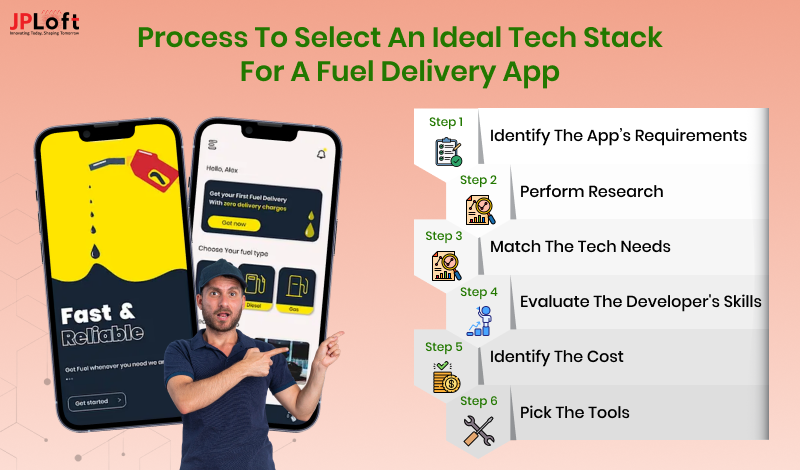
Thus, here’s the process to follow.
Step 1: Identify the App’s Requirements
You should evaluate the app’s requirements, its target audiences, and features. This is the first step towards an ideal tech stack for a fuel delivery app.
Step 2: Perform Research
Under the research process, you should carry out the competitors' strategy, the core audience’s needs, and how you can align them by selecting ideal technologies.
Step 3: Match the Tech Needs
In this stage, you should be able to analyse the needs of your app by considering the factors impacting the selection of an ideal tech stack.
Step 4: Evaluate the Developer's Skills
Now, it's important to identify the skills of the developers who are responsible for creating your ideal fuel delivery app.
Step 5: Identify The Cost
It's vital to evaluate the cost before you step ahead with the technologies. Here, it's all about evaluating the cost to adopt and implement every technology for your fuel delivery app.
Step 6: Pick the Tools
Well, let’s get ahead with the tools to build an ideal tech stack for a fuel delivery app. It is one of the important segments to continue with the cost.
These were the steps that you can get ahead with.
Connect With JPLoft and Proceed With an Ideal Fuel Delivery App Tech Stack
Are you the one searching for a team of experts to implement an ideal fuel delivery app tech stack?
Partner with JPLoft and know the actual requirements of your customized fuel-delivery app. Our team is ready to perform all the research for your app.
We are the leading Fuel Delivery App Development Company focused on delivering honesty and integrity with every step to build your dream app
Our team of experts will consult you at every step to identify and discuss all your requirements, then match them with the current trends to make you lead the industry.
Conclusion
Well, selecting the right tech stack is foundational for a successful fuel delivery app. Here, you have navigated the essential components, from front-end frameworks like React Native and Flutter to back-end languages such as Python and Node.js, alongside crucial database choices like PostgreSQL and MongoDB.
Factors like project aims, features, cost, and available technologies significantly influence this decision. By understanding these strategic pillars and following a structured selection process, entrepreneurs can build a responsive, scalable, and secure fuel delivery platform tailored to their specific needs and market demands.
FAQs
To start a fuel delivery app business, you will be required to obtain the necessary licenses and permits, develop a business plan, and build a fleet of fuel delivery vehicles.
The core components include the front-end (for user and driver apps, like React Native or Flutter), the back-end (for server-side logic, such as Node.js or Django), a database (like PostgreSQL or MongoDB), real-time tracking via mapping APIs, payment gateway integration, cloud services for hosting, push notifications, and authentication for secure user access.
Key factors include the project's aims and required features, the associated development and operational costs, the specific technologies desired, and the need for responsiveness, scalability, security, and ease of future updates and maintenance. Understanding these pillars is crucial for making informed decisions.
Choosing the right tech stack improves the app's responsiveness, especially for real-time tracking, adds flexibility for future growth and feature integration, impacts development cost and time, ensures robust app security for sensitive data, and facilitates efficient updates and long-term maintenance.
Popular front-end technologies include React Native and Flutter for cross-platform mobile development, allowing for a single codebase deployment on both iOS and Android. For web-based admin panels, HTML, CSS, JavaScript, with frameworks like React or Angular are commonly used.






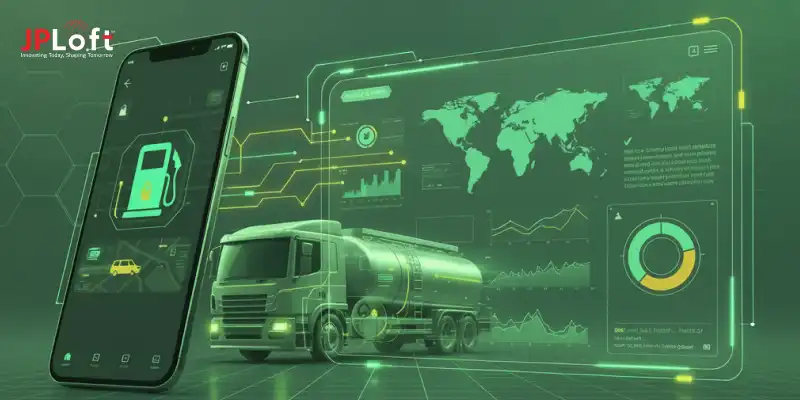
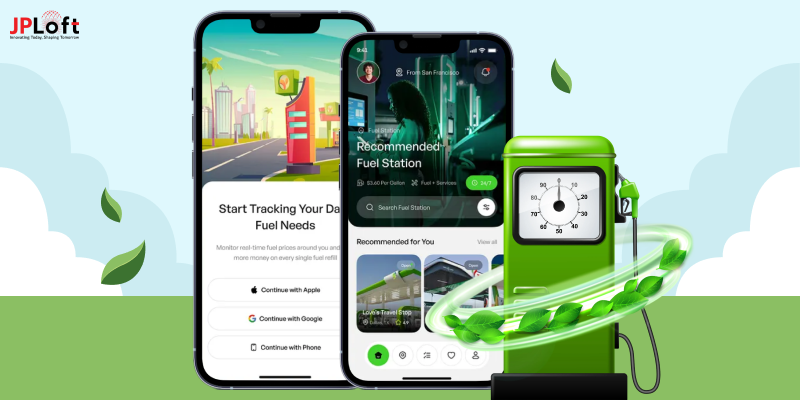
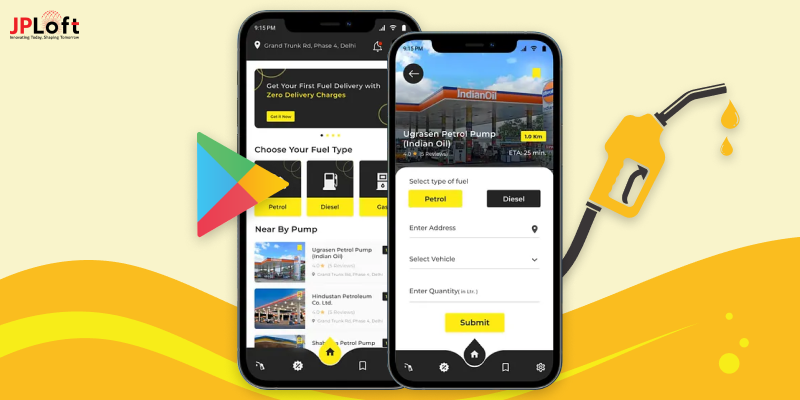


Share this blog